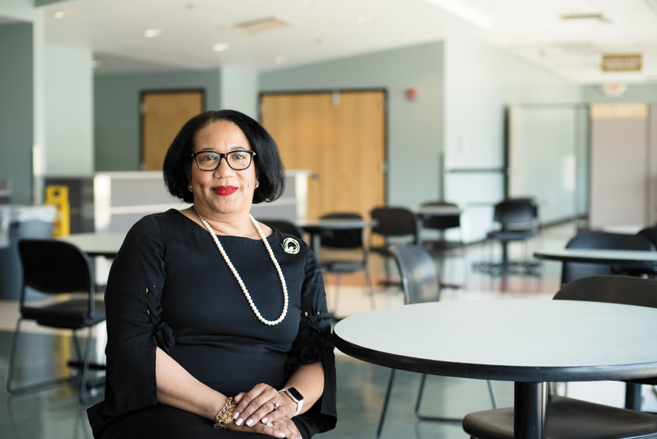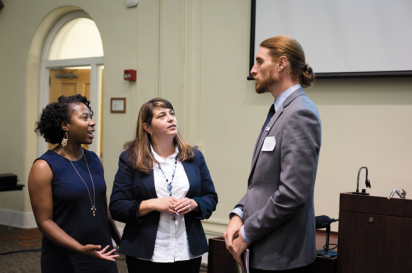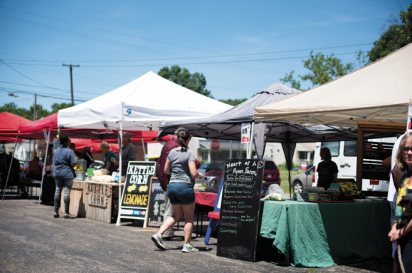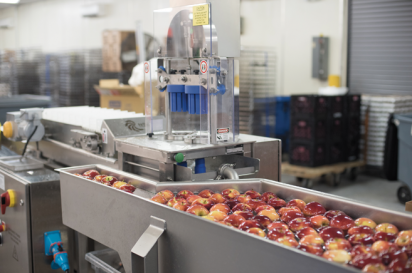Building a Better Food System
The U.S. Department of Agriculture’s Economic Research Service (USDA ERS) reports that in 2016, 20% of Ohio’s children were “food insecure.” These youth and their families did not know where they would find their next meal—perhaps they visited a food pantry, community kitchen or fast-food restaurant to find something free or affordable to eat, or maybe they skipped dinner some nights.
Despite our state’s deep agrarian roots, less than 6% of agricultural sales in Franklin County are for fruits, vegetables and livestock, according to the most recent U.S. Census of Agriculture, in 2012. USDA ERS reports that in 2016, nearly 15% of all Ohioans were food insecure. Nationally this average was 13%. Crops leave the state while citizens nearby remain some of America’s most hungry.
Obviously, change is needed.
The City of Columbus and Franklin County Local Food Action Plan, adopted in late 2016 by Columbus City Council and the Franklin County Board of Commissioners, creates a framework for transforming the food system. An ambitious effort to address chronic food insecurity and build a resilient local food network in our region, the Plan is rooted in the vision of “a fair and sustainable food system that benefits our economy, our environment and all people.”
Now almost two years into implementation, the Plan is weaving together a diverse network of stakeholders in Central Ohio who are knee deep in the work of growing our local food economy and addressing food accessibility and affordability in our region’s most vulnerable neighborhoods.
A Community Vision
The Local Food Action Plan is comprised of four hefty goals: “Enhance coordination and communication among existing food resources and agencies; improve access to and education about healthy food, affordable food and local food; increase the role of food in economic development; and prevent food-related waste.” With significant action steps identified for each goal, including policy change, the creation of networks and enterprises and the development of training and tools, the Plan is bold, far-reaching and potentially hugely impactful.
Extending beyond food, the framework aims to address the underlying issues of poverty, underemployment and unemployment in our region. “We know that food is important to the physical and economic health of our community and its residents,” says Priscilla Tyson, a member of Columbus City Council and a legislative sponsor of the Plan. “It was clear that we needed a comprehensive food plan that includes everyone who contributes to the food system.”
The Plan was brought to life through a two year development process led by the City of Columbus, Franklin County and Local Matters, a Columbus nonprofit that focuses on food education, access and advocacy. Community input was crucial to ensure that the Plan addressed the needs of residents of all means.
The effort has been recognized nationally for the diversity of participants brought together to craft a common, shared framework. “The approach that we are taking is comprehensive and collaborative,” says Franklin County Commissioner John O’Grady, also a legislative sponsor of the Plan. “We are bringing all of the resources that we have in Central Ohio to the table and that’s a unique thing. We are doing this because we care about the community, we want to make sure people get fed and we want to make sure that our food economy is thriving.”
Feedback from more than 1,000 Franklin County residents was gathered through community surveys, interviews and meetings. Eight hundred potential actions to change the food system in our region were identified and later whittled down to the 27 actions included in the final Plan. “There was a real need for a community-informed plan,” says Cheryl Graffagnino, local food system strategies coordinator with the Columbus Public Health Department. “The Plan is bigger than what the city and county can do alone.”
According to Cheryl, although city and county government and public and private actors in the community have a long history of supporting local food initiatives, “there wasn’t a strategic coordinated effort around local food” prior to the creation of the Local Food Action Plan. “Everybody recognized that we could do better.”
Pursuing Change
As the legislative sponsors, Councilmember Tyson and Commissioner O’Grady oversee the network leading the action steps for a reimagined local food system in Central Ohio. The sponsors have requested that within five years significant progress is made on each of the Plan’s four goals.
A 12-member advisory board, called the Local Food Board, comprised of influential community leaders representing public and private sector food and agriculture entities, meets quarterly to oversee implementation of the Plan’s actions.
The Local Food Board is supported by a team of three staff members, including Cheryl, who are funded by the city and county, called the Local Food Team. This group facilitates the day-to-day work of implementing the Plan, including connecting food system players and tracking and reporting progress.
Project teams, comprised of a variety of stakeholders, work on achieving progress on each of the individual actions identified in the Plan. Project teams have formed around actions like supporting local farmers markets and the development of resources to grow local food businesses.
Community engagement is encouraged through the Franklin County Local Food Council, an independent entity founded in 2011 who helped to craft the Plan and who are aiding in its implementation. At the Council’s monthly meetings, which are open to the public, there is an emphasis on information-sharing regarding progress on the Plan’s actions
“For the next couple of years our focus will really be on acting as a connector and convener for the Local Food Action Plan,” says Karima Samadi, co-chair of the Council. “Community outreach and engagement for this task is important to us because we need to make sure that everyone in our community is heard as the Plan is being implemented.”
A Living Document
At a recent meeting of the Health & Human Services Committee of Columbus City Council, led by Councilmember Tyson, she noted that the Plan was not drafted to simply “sit on a shelf.” When the issue of regulatory setbacks that impact the production of food within city limits was raised during public comment, Councilmember Tyson said, “We will put together a team to work with Building and Zoning Services to address this issue.”
Will the Local Food Action Plan succeed in transforming Central Ohio’s food system? If left to vision and commitment, the answer appears to be a resounding “Yes.” As the Plan’s stakeholders dig in their feet to move implementation forward, there is great hope that change is on the horizon.
Learn more and follow progress at columbus.gov/lfap.
We’d like to share several stories with you that have roots in the Local Food Action Plan’s ambitious framework. These stories bring to life the platform and demonstrate the powerful and real impact the Plan may have on the communities, economies, businesses and people in our region.
Linden Farmers Market
It’s a hot July day. Atop sizzling blacktop, 20 booths showcase a diversity of prepared foods: tamales, homemade pies, pickles and salsa. Tables with vegetables and fruit overflow with the abundance of midsummer’s harvest. Nearby a vendor sells West African–inspired textiles while a food truck makes crepes. The sounds of laughter and music fill the air.
This is the recently launched Linden Farmers Market, held on Sundays from 1 to 4pm during July and August in the parking lot of Gye Nyame Place at 2830 Cleveland Avenue.
An initiative of the City of Columbus; Community of Caring Development Foundation, the nonprofit arm of nearby New Salem Baptist Church; and the Ohio Farmers Market Management Network, the market is focused on “accessibility and affordability,” according to Landon Adams, the market’s manager. Linden saw its last major grocery store, the Kroger at 3353 Cleveland Avenue, shutter its doors earlier this year. Centered on community empowerment, Landon notes, “This is a nontraditional farmers market. It’s a community market.
There will always be something to learn and experience. We want it to be a hub of cultural and community exchange.”
The market aims to fill its booths with a percentage of vendors who live, work or worship in Linden in the hopes of not only providing fresh food to the community but also opportunity. At a Columbus City Council committee meeting in July, Landon reported that 17% of the vendors at the market lived, worked or worshipped in Linden, 26% of the businesses at the market were minority-owned and almost 40% were owned by women.
Through funding from Columbus City Council as part of the group’s investment in the Local Food Action Plan, members of the Greater Columbus Growing Coalition who sell product at the market are covered by the organization’s general liability insurance policy.
Victoria Meacham, owner of Aunt Vickie’s Pies, is a parishioner at New Salem Baptist Church. A single mother, she hopes that her booth offering freshly baked pies may inspire others who want to turn a hobby into a source of income. “If people come up to me and ask me how to create something like this, I want to help them,” she says.
The market fills as a service at the church lets out. The church, a steadfast pillar in the community, has deep roots tackling food insecurity in Linden with a well-established food pantry, a weekend food bag program for children in a nearby elementary school and a free community dinner that feeds approximately 200 people a week. New Salem donated land for the market and their parishioners have committed to weekly patronage.
“When we were approached for the farmers market it was a natural fit,” says Landon, a parishioner at New Salem himself. “Though some church members may not live in the neighborhood, we understand that as an institution we are part of the neighborhood.”
Many of the market patrons that I stop to speak with have just attended the church service.
For Linda Bozeman and Valerie Raimey the diversity of products at the market is attractive. Linda tells me that she just purchased a chipotle raspberry salsa that’s “to die for.” Valerie adds that she’ll be making squash and fried green tomatoes for dinner that night from supplies bought at the market.
“It’s good fellowship. We love it,” Linda says. Parishioner Mary Richardson adds, “Most of us are trying to eat better. We like knowing that the food here is fresh.”
Follow on Facebook and Instagram @lindenfm.
Ohio Apples in Ohio Schools
This year, students in the Columbus City Schools’ elementary network, comprised of more than 70 schools and 30,000 students, will be offered nearly three million apples from Ohio. Even better, for the first time ever, these apples will be served sliced rather than whole, a difference that has proven to increase intake by students and reduce food waste. The potential impact on the local food economy and student health is real and staggering.
“They are fresher, they taste better and they are less expensive. It’s a win across the board,” says Joe Brown, director of food services for Columbus City Schools, the largest school district in the state, regarding his team’s procurement of Ohio apples.
Previously, all apples were purchased and shipped from the state of Washington. The apples were served whole, as kitchens in elementary schools in the district are equipped only with refrigeration and warming units, not processing equipment, and procuring sliced and packaged apples from a distributor was cost-prohibitive.
Joe served as a working committee member for the development of the Local Food Action Plan and he used this network to seek a solution for his team’s apple sourcing. Additionally, Columbus Public Health conducted a food waste audit for the district, which demonstrated that if offered sliced apples, elementary students would eat significantly more of the produce.
“We found that the kids ate almost four and a half times as many apples when they were sliced as opposed to whole,” says Cheryl Graffagnino, local food system strategies coordinator with the Columbus Public Health Department. “Waste went down by 55%. It was tremendous.”
Joe worked with a team comprised of staff from Columbus Public Health, Franklin County Public Health, Ohio Farm to School and Ohio State University Extension to draft a U.S. Department of Agriculture Farm to School grant application for the purchase of equipment to clean and slice fresh apples. The team was awarded nearly $100,000 and the equipment was installed over the summer. The equipment will initially be used for processing apples with the goal of expanding to other fresh, and ideally local, produce.
“It’s been interesting going through this process and learning the capacity we have within our community,” Joe reflects. “Seeing the commitment and dedication behind growing our local food system has been really encouraging.”
For Cheryl, whose role at the Columbus Public Health Department focuses on implementing the Local Food Action Plan, supporting the Columbus City Schools Farm to School grant win was thrilling.
“Being able to help people connect is the most rewarding part of my job but I also think it’s the thing that’s ultimately going to get the end result that we are looking for,” she says, regarding the transformational goals outlined in the Local Food Action Plan. “The Plan has given people a platform for recognizing where they could work together to impact change.”
This teamwork has also been demonstrated through the “Ohio Days: My Plate, My State” program offered by Joe and his crew at Columbus City Schools. Each month, the district offers a meal of Ohio-only products in the cafeterias of more than 100 Columbus schools. Joe credits the strong local food community in Columbus, including members of the Local Food Team, in helping make this program a success.
“We weren’t sure how we were going to get local products,” Joe says. “The team with the Local Food Action Plan stepped up to help. They helped us source vendors, with communication about the program and with creating educational materials for our schools.”










